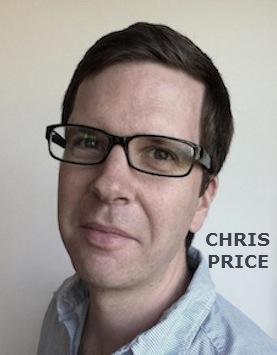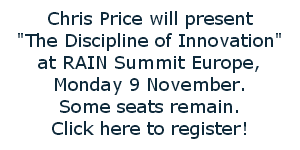 This guest column by Music Content Strategist and former BBC, MTV and Last.fm executive Chris Price, was originally published on his New Slang Media site. He can be reached at @chrispricey. Chris Price is a featured speaker at RAIN Summit Europe, Monday November 9 in London. CLICK HERE for info and registration.
This guest column by Music Content Strategist and former BBC, MTV and Last.fm executive Chris Price, was originally published on his New Slang Media site. He can be reached at @chrispricey. Chris Price is a featured speaker at RAIN Summit Europe, Monday November 9 in London. CLICK HERE for info and registration.
“The first track we’re gonna play for you – well, you can press play on it if you want – is off the new Tame Impala album …”
Is this how radio will sound in the future? Depending on your definition of radio, it already does. That’s Jungle introducing the first track on their ‘In Residence’ playlist for Spotify, a new series that’s been referred to as the latter’s ‘own take on original, artist-driven radio’, possibly as a response to Apple’s Beats 1 live radio offering from the likes of Joshua Homme and St. Vincent.
This kind of self-referential pronouncement – “you can press play if you want” – is likely to become a more frequent feature of radio that knows itself to be non-linear, on-demand, skippable, and integrated with (nearly) all of the world’s music. Broadcast radio and streaming services edge one step closer to one another like nervous teenagers across the dance floor at a high school prom.
Sensibly Spotify appears to be launching its ‘In Residence’ series quietly, having elected to put up the first four ‘shows’ in the series – Jungle are joined by Steve Jones, Big Narstie and Tonga – without fanfare. It’s an interesting approach to the human touch conundrum that streaming services increasingly find themselves competing around, and of course it’s nothing new.
 Slacker Radio has been doing hosted, skippable radio for years, and they’ve gotten pretty good at it. Spotify’s ‘In Residence’ series is essentially Slacker’s ‘I Am The DJ’ franchise by another name and, as Annika Walsh points out, Blinkbox (then We7) was doing similar stuff back in 2011.
Slacker Radio has been doing hosted, skippable radio for years, and they’ve gotten pretty good at it. Spotify’s ‘In Residence’ series is essentially Slacker’s ‘I Am The DJ’ franchise by another name and, as Annika Walsh points out, Blinkbox (then We7) was doing similar stuff back in 2011.
But it goes back much further than that. This type of hosted playlist – essentially presenter links (or breaks, as US readers know them) recorded in isolation and assembled between songs – is much closer to linear radio than you might think. Since at least the 1970s, FM radio has leaned on ‘voice-tracking’, in which a host records links that are then played out in sequence by a studio automation system, as a cost-cutting measure.
 Making radio this way means you can pre-record a 3-hour show in less than 20 minutes, allowing cash-strapped stations to do more with less. If you listen to local commercial radio, where the breakfast show host is very likely the head of music as well as the programme director, there’s a good chance that much of what you’re hearing is voice-tracked. It’s not pretty, but sometimes needs must.
Making radio this way means you can pre-record a 3-hour show in less than 20 minutes, allowing cash-strapped stations to do more with less. If you listen to local commercial radio, where the breakfast show host is very likely the head of music as well as the programme director, there’s a good chance that much of what you’re hearing is voice-tracked. It’s not pretty, but sometimes needs must.
It’s this space that streaming services are moving into. By inviting the listener to press play ‘if you want to’ (or, as I heard Jungle say about a Loyle Carner track in a later link, “it’s not on Spotify unfortunately but check it out”), hosted playlists are arguably more honest than voice-tracked linear radio.
 Apple has taken the fully ‘live’ approach to the human touch in the form of Beats 1, but even they don’t pretend that every single show is truly live, repeating each of Zane Lowe, Ebro Darden and Julie Adenuga’s shows once per day.
Apple has taken the fully ‘live’ approach to the human touch in the form of Beats 1, but even they don’t pretend that every single show is truly live, repeating each of Zane Lowe, Ebro Darden and Julie Adenuga’s shows once per day.
And when you’re broadcasting globally across multiple time zones, as Beats 1 is, just how important is it to be truly live? When traditional radio dayparts – breakfast, drive, overnights and so on – no longer apply, it’s impossible to create time-specific features like ‘sunset moments’ or wake-up songs that weave themselves into the life of the listener.
So Spotify doesn’t try, at least not in its hosted output, leaving its ‘Now’ feature to supply the time- and context-specific stuff that traditional radio does so well. For now it appears content to add the human element only at the discovery end of spectrum – as Beats 1 does, being an almost 100% unfamiliar listen by traditional radio standards. Whether we eventually hear presenters announcing Spotify’s ‘Global Top 50’ – or a more musically familiar Beats 2 from Apple perhaps – remains to be seen.
But what about the response from traditional radio? We’re already seeing the first stirrings of interactivity from some broadcast quarters. The BBC has announcedits ambitions to enter the streaming space by offering a Pandora-style evolution to its Playlister product, and ‘skippability’ – to judge by the number of times it comes up in conversation with my own broadcast clients at least – is increasingly on the agenda.
Labs.fm, a Cape Town-based radio technology incubator I have an advisory role with, is already working with broadcasters and streaming services to bring skippability to the linear listening experience using itsRecast technology. And if the rumours of hastily negotiated label licensing terms are true, Global plans to launch something similar – an app offering a live radio experience with skips – this very week.
Update: Global have now launched a new app for Capital Xtra which, as rumoured, features skippable linear radio. It’s pretty nifty – here’s a video:
It might be a while before we hear Radio X’s Chris Moyles announcing: “This is the new Mumfords tune; we love it, but if you’re not a fan just skip it and we’ll see you back here in a few minutes”; but that appears to be the direction of travel, and there are smart people working hard on making it a reality. The likelihood is, given that there’s no presenter ego to get past, that we’ll see this kind of functionality on non-hosted, era-based digital channels like Absolute’s ‘decades’ stations first.
But why would linear radio want listeners to skip songs? Surely, having invested all that time and effort curating such delightful sweeps of music, letting people hit ‘skip’ demonstrates a lack of confidence in their own programming? Well, perhaps, but currently the broadcast radio listener has two options when they hear a song they don’t like – put up with it or tune out. A skip functionality holds the listener for longer, allowing stations to serve up more of their own content, branding and – of course – advertising.
And all that skip data adds up to valuable analytics that can feed back into a linear programming strategy. Capital Xtra’s head of music now has a valuable tool that other stations don’t have: for every track in their library they will know how often, where in the song (duration-wise) and when in the song’s life-cycle people are skipping. Having seen the skip analytics behind Recast, I can tell you – as a former head of music myself – that it’s powerful information.
So streaming services have interactivity nailed and are making progress with human curation. Radio on the other hand has had the ‘human’ part down for decades and is making strides in interactivity. It makes for a pretty crowded and angst-ridden dance floor, as if the band could stop playing at any minute before planting that first kiss. But I for one – working on both sides of it – am enjoying playing match-maker in the mean time.

